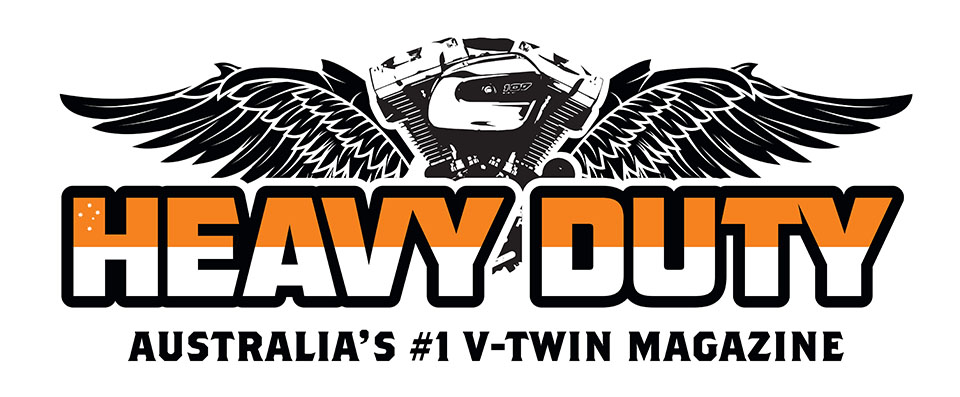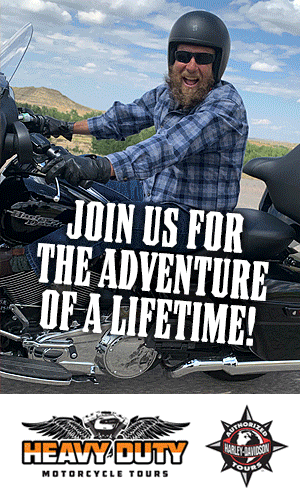Issue 176
/Daytona Bike Week
I feel sorta let down. I predicted that Harley-Davidson would have something to show us at Daytona Bike Week like it did way back in 1977 with the release of the first Low Rider FXS. But no; except for eight local dealers providing demo bike rides including the LiveWire.
That said it did provide the charity “Get Out and Ride Sweepstakes” bike, a custom Road Glide Special FLTRXS which was fully chromed and painted in a beautiful marine blue with a Daytona 80th Anniversary tank logo.
But hey… There is always 2022 at www.heavyduty.com.au/tours
Pan America 1250 & Revolution Engine
The production Pan America 1250 was a no show at Daytona. That said there is plenty of information and videos of it on the web. Even better than the official factory video is Matt Laidlaw’s 33 minute extended version on his YouTube channel. You can go to Cybercycles at www.heavyduty.com.au/cybercycles for the best of everything you need to know about the Pan Am and its new Revolution Max 1250 engine.
From what I have seen in these reviews and videos, the RevMax engine is equal to or better than its competition and at a fair price.
Now the naysayers, including myself, are asking the question why is Harley-Davidson going “Off-Road” with the Pan America? The fact is that Harley was a dirt bike market in the early years. The reason then was simple: Almost all the roads in the early 1900s were dirt!
Blame it on Elvis
So I have a theory for you to prove me wrong: Harley-Davidson started its mindset to go “On-Road” well after World War Two and with the delivery of Elvis Presley’s FLH Hydra-Glide in 1956. Elvis set the style for those wannabe rock and roll stars with white side wall tyres, a black leather Marlon Brando jacket, penny loafers with white socks, long side burns and a windshield for highway cruising.
But then when AMF bought Harley in 1969, and being like Polaris today, it wanted to keep its fingers in as many pots as possible, AMF heavily advertised the Harley-Aermacchi’s light-weight dirt bikes. Harley’s MX-250 even won outright the 1975 Baja 500. But then when AMF lost interest in the Motor Company, Willie G and the Gang of Thirteen bought back Harley-Davidson and made it clear that on-road bikes were the future for profitability.
Off-road Harleys took a back seat. The closest thing to dual-sport adventure bikes were the flat track KR750, XR750 and XG750R racers; and the Buell ventures.
You can read highlights of Harley’s dirt bike history at www.revzilla.com. There Mark Gardiner tells us about the newest Harley-Davidson Museum exhibit “Off-Road Harley-Davidson” with a guided tour by the curator, Dave Kreidler. The full article is a must-read along with the background links listed at www.heavyduty.com.au/cybercycles
Hardwire Plan
So right now Harley is putting its money in the Hardwire Plan. I am guessing the LiveWire will either sink or swim by its sales record. And if there are more follow-on electric bikes they will be cost competitive and fill a need that the market demands.
Today, the Pan America 1250 is carrying the ball for any endeavour outside of Harley’s core riders and market. I expect a dual sport Harley 975cc will fill the sweet spot in the market. Perhaps the Sportster II and Custom 1250/Revolution Max 975?
The Hardwire Plan is to build bikes that its customers want and then, only enough of them to meet demand. Dealers buying and selling pre-owned Harleys is key to this marking plan. Prices will be driven by supply and demand.
With the Pan America, Jochen Zeitz and his new Hardwire crew are really going back to the roots of the founding fathers.
H-D from 1903
In the beginning with only dirt tracks and wooden bridges, it took the likes of pushbike riders in 1880 and their Good Roads Movement to convince the governments to start paving roads. Motorbikes could go further into the woods on deer trails than anything else.
Roads were paved in World War One and Two to get the war materials from the source to the port and off to war. After World War One, a Lt Col Eisenhower accompanied the 1919 Transcontinental Motor Convoy taking the Lincoln Highway from Washington DC to San Francisco. Pilots riding Harley-Davidson and Indian motorcycles marked the route ahead of the convoy.
At an average speed of six miles per hour, most of the vehicles were damaged beyond repair by the end of the 3000-mile trip having had 230 road accidents and damaging or destroying 88 wooden bridges. That convoy encountered the same roads outside of towns that the locals had to travel each day, mostly by horse and wagon.
Today’s highlights in the Museum exhibit are the Harley adventure bikes of the past 100-plus years.
The 1914 Model 10-F “hamburger with the lot” of its day had a two-speed transmission, step starter, chain drive, drum brakes and eight horsepower. It weighed only 285 pounds and sold for one dollar per pound, $285.
Jumping to 1921, the WJ Sport 584cc boxer twin engine had a whopping six horsepower and a ground breaking “keystone” frame using the engine as a stressed member.
In the beginning race bikes were mostly dirt bikes with wooden board racers coming along later. The original 1958 XLCH Sportster was a flat track racer without lights and muffler. It had 55 horsepower and was able to do 115 mph (255 km/h).
The 1959 model was made to be street legal.
In the 1960s the Harley-Aermacchi 250cc Sprint racers idled at 2500 rpm but went like stink.
Then in 1975 the MX-250 prototype was raced by Bruce Ogilivie, winning the Baja 500 against the world’s best! But sadly in 1979 Harley sold Aermacchi.
In 1985, Erik Buell joined Harley and made his mark on the design team for the new FXR.
In 1988 Charlie Peet and Fort Lauderdale H-D built an off road FXR to compete in the 9000-mile long Trans-Amazon Rally. Charlie being all alone was voted before the rally as the person most likely not to finish. He not only finished but was one of only four bikes that did! His FXR was bought back by the Motor Company for future study.
Erik Buell stayed on with Harley and they released the Buell Ulysses dual sport bike in 2006. That all ended in 2009 but today he has resurrected Buell Motorcycles and his Fuell electric Fllow-1S at $11,000 is acclaimed for future production.
As a side note, Ewan McGregor and Charlie Boorman took a whole film production team and a couple of much modified LiveWires up the middle of South America and across the Amazon River in 2020. The point here is simple: Harley isn’t the new kid on the block but rather it is getting back to its roots. HD




